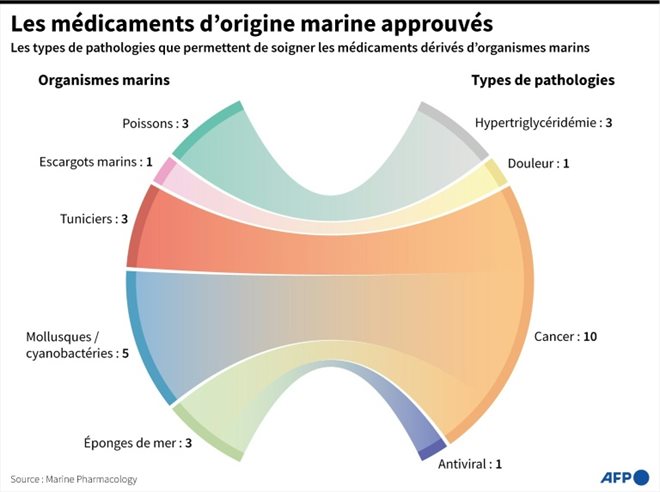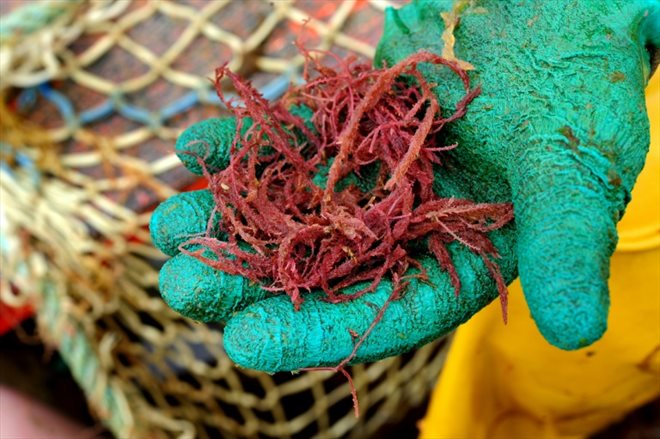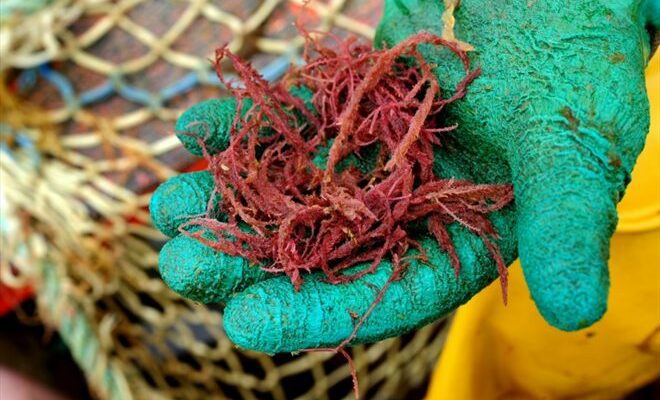Sea squirts clinging to oyster lines (AFP/Archives/Boris HORVAT)
They are hidden in the microbes of the sediment, in a bacterium living in symbiosis with a sea snail or hidden in the secretions of a sponge: the molecules which will provide a future revolutionary treatment against cancer or a new powerful antibiotic are sought at the bottom. of the seas by scientific explorers.
Constrained by tight budgets and little support from major laboratories, scientists often have to join other expeditions and compete in imagination to recover their samples, sometimes a simple tube of mud.
When a discovered molecule has finally revealed its benefits, on Alzheimer’s disease or epilepsy for example, it still takes more than a decade, and hundreds of millions of dollars, to transform it into a drug.
This innovative but still modest exploration is in the spotlight, in the midst of negotiations for a crucial United Nations treaty on the high seas. The last session of negotiations, which concludes Friday, tries to reach an agreement on marine areas protected.
States are fighting over the sharing of benefits derived from marine genetic resources, in particular those used in medicines, bioplastics or food additives, explains Daniel Kachelriess, co-manager of negotiations for the High Seas Alliance, a coalition of NGOs.
Yet only a small number of products derived from marine genetic resources find their way to the market. Only seven registered in 2019, according to him.
Potential licensing fees are estimated to be between $10 million and $30 million per year. There is probably much more to discover in the phenomenal biological diversity of the oceans.
– Anti-cancer –
“The more we seek, the more we find,” says Marcel Jaspars, from the University of Aberdeen in Scotland.

Drugs of marine origin approved (AFP/Julia Han JANICKI)
Since Alexander Fleming, in 1928, discovered a mold that repels bacteria, penicillin, researchers have found healing molecules in plants, animals, insects and microbes…on earth.
“The vast majority of antibiotics and cancer drugs come from natural sources,” said William Fenical, a professor at the Scripps Institute of Oceanography in California.
When this 81-year-old pioneer, still at the head of a laboratory, began research on marine molecules in 1973, skepticism reigned around the possibility of doing the same under the sea.
But in the 1980s, he and his colleagues discovered a soft coral in the Bahamas. It produced an anti-inflammatory molecule, which ended up in Estée Lauder cosmetics.
The quantities needed eventually led them to focus on microorganisms. Now, researchers collect sediments and then cultivate the microbes in the laboratory.
Also in the Bahamas, in 1991, researchers identified an unknown bacterium, Salinispora. Today, it has led to two anti-cancer drugs, now at the stage of final clinical trials.
– Sea squirt –
This long journey comes as no surprise to Carmen Cuevas Marchante, head of research at PharmaMar, a Spanish biotech company.
For its first drug, this company began by collecting 300 tonnes of bulbous sea squirt, one of those species of cylindrical invertebrates clinging to rocks or under boats.
“It took us a ton to isolate less than one gram” of the molecule needed for the tests, Ms. Cuevas Marchante told AFP. The company drew from it three authorized anti-cancer drugs and refined its methods of synthesis.

Collection of red algae which has antiseptic properties, May 12, 2009 in Ouessant (AFP/Archives/FRED TANNEAU)
A total of 17 marine-derived drugs have been licensed to treat human diseases since 1969, and about 40 of them are in various stages of clinical trials around the world, according to the Marine Drug Pipeline website.
Most of these drugs treat cancer, but there is also a herpes antiviral from a sea sponge and an analgesic from a snail.
According to experts, this limited number is partly explained by the enormous cost of trials – sometimes beyond a billion dollars – which favor the development of more expensive drugs.
There is a “myriad” of research, however, from malaria to tuberculosis, said Alejandro Mayer, professor of pharmacology at Midwestern University.
The molecule of the next antibiotic or the future treatment against HIV may be waiting buried in a creature at the bottom of the sea or wisely hidden under the hull of a boat. Unless it is already in our possession, in the immense libraries of molecules which remain to be tested.
© 2023 AFP
Did you like this article ? Share it with your friends with the buttons below.




